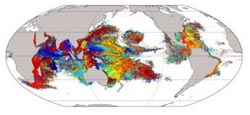Epic ocean voyages of coral larvae revealed

The pathways traveled by >14 million modeled coral larval over a one-year period using the Connectivity Modeling System developed by Dr. Claire Paris at the University of Miami. Note the empty no-man's-land that larvae have difficulty breaching -- this is the East Pacific Dispersal Barrier.<br><br>Credit: S. Wood/Univ. of Bristol<br>
A new computer simulation conducted at the University of Bristol (UB) and University of Miami (UM) Rosenstiel School of Marine & Atmospheric Science has revealed the epic, ocean-spanning journeys travelled by millimetre-sized coral larvae through the world's seas.
The study, published in Global Ecology and Biogeography, is the first to recreate the oceanic paths along which corals disperse globally, and will eventually aid predictions of how coral reef distributions may shift with climate change.
Coral reefs are under increasing threat from the combined pressures of human activity, natural disturbances and climate change. It has been suggested that coral may respond to these changing conditions by shifting to more favourable refuges, but their ability to do this will depend on the ocean currents.
Sally Wood, a Ph.D. candidate at UB, explains: “Dispersal is an extremely important process for corals. As they are attached to the seafloor as adults, the only way they can escape harmful conditions or replenish damaged reefs is by releasing their young to the mercy of the ocean currents.”
Where these intrepid explorers end up is therefore an important question for coral reef conservation. However, tracking the movement of such tiny larvae in the vast oceans is an impossible task. “This is where computer simulation comes in,” adds Wood.
Collaborating across the pond, Wood used the Connectivity Modeling System (CMS) developed by Dr. Claire Paris, associate professor of Applied Marine Physics at UM to identify the billions of paths taken. This larval migration model had been tested in a previous study against the reef-building coral Montastraea annularis in the Caribbean, where consensus between modeled estimates of genetic structure were found.
“Simulating an unprecedented number of mass spawning events from all known shallow reefs in the global ocean proved essential to identifying critical long dispersal distance events that promote the establishment of new coral colonies. What we found using the CMS are rare long distance dispersers that are thought to contribute to species persistence in isolated coral reefs, and to geographic range shifts during environmental changes,” said Paris.
Some of the results yielded by the team were surprising. While the majority of simulated larvae settled close to home, others travelled as far as 9,000 km., almost the entire width of the Pacific Ocean. When considered over multiple generations, this means that corals are able to cross entire ocean basins, using islands and coastlines as 'stepping stones.' However, a few places proved too distant for all but the hardiest of larvae: Coral in the tropical eastern Pacific are almost entirely cut off from those on islands of the central Pacific by a daunting 5000 km of open ocean. Geographically isolated reefs such as these may be particularly vulnerable, as they are not stocked with external recruits as frequently.
The model captured the start of the coral larvae's journey to its survival, and further work is ongoing to complete the story. Even after overcoming the trials of the open ocean, coral larvae arriving at a suitable location must first negotiate a 'wall of mouths' to settle on the reef face, and then compete fiercely for the space to thrive and grow.
Development of the CMS was funded through the NSF-RAPID program (OCE-1048697) to CBP.
The University of Miami's mission is to educate and nurture students, to create knowledge, and to provide service to our community and beyond. Committed to excellence and proud of the diversity of our University family, we strive to develop future leaders of our nation and the world. Founded in the 1940's, the Rosenstiel School of Marine & Atmospheric Science has grown into one of the world's premier marine and atmospheric research institutions. Offering dynamic interdisciplinary academics, the Rosenstiel School is dedicated to helping communities to better understand the planet, participating in the establishment of environmental policies, and aiding in the improvement of society and quality of life. For more information, please visit http://www.rsmas.miami.edu.
Paper: 'Modeling dispersal and connectivity of broadcast spawning corals at the global scale', by S. Wood, C.B. Paris, A. Ridgwell, & E.J. Hendy. Global Ecology and Biogeography (2013).
Media Contact
More Information:
http://www.rsmas.miami.eduAll latest news from the category: Ecology, The Environment and Conservation
This complex theme deals primarily with interactions between organisms and the environmental factors that impact them, but to a greater extent between individual inanimate environmental factors.
innovations-report offers informative reports and articles on topics such as climate protection, landscape conservation, ecological systems, wildlife and nature parks and ecosystem efficiency and balance.
Newest articles

Silicon Carbide Innovation Alliance to drive industrial-scale semiconductor work
Known for its ability to withstand extreme environments and high voltages, silicon carbide (SiC) is a semiconducting material made up of silicon and carbon atoms arranged into crystals that is…

New SPECT/CT technique shows impressive biomarker identification
…offers increased access for prostate cancer patients. A novel SPECT/CT acquisition method can accurately detect radiopharmaceutical biodistribution in a convenient manner for prostate cancer patients, opening the door for more…

How 3D printers can give robots a soft touch
Soft skin coverings and touch sensors have emerged as a promising feature for robots that are both safer and more intuitive for human interaction, but they are expensive and difficult…





















